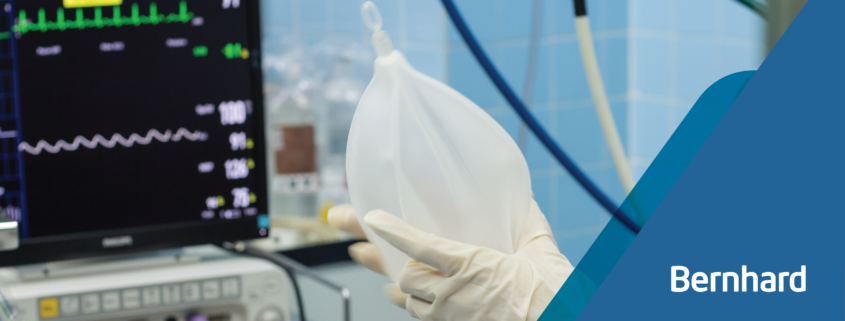The Hidden Environmental Impact of Anesthetic Gases: A Call to Action
By: Diana Husmann, David Lamberson, Cami Lambert
In the ongoing global dialogue about climate change and greenhouse gas (GHG) emissions, it’s easy to miss certain unexpected but significant contributors to the issue. One area that’s often overlooked is the use of Inhaled Anesthetic Agents (IAA) like sevoflurane, isoflurane, nitrous oxide, and desflurane by the healthcare sector.
Used for decades to reduce anxiety and safely induce a painless unconsciousness during surgical procedures, there’s growing recognition that IAAs are powerful greenhouse gasses, with hundreds or even thousands of times more heat-trapping potential than well-known global warming contributors like carbon dioxide. Exhaled by patients as waste gas and routinely vented directly to outside air during procedures, some of these IAAs can linger in the atmosphere for well over a century.
Climate change and global warming are a growing threat to the planet and human survival, so many hospital campuses in the United States are taking a new look at anesthetic gasses and their use, including choosing those with the least environmental impact. With partners like Bernhard specializing in greenhouse gas mitigation and carbon footprint reduction, healthcare systems across the U.S. are also developing strategies for tracking IAA leakage while re-examining their policies on venting and reclaiming waste IAAs before they can reach the environment.
Through commonsense efforts to limit the use and venting of certain particularly damaging IAAs, hospitals can not only help save the environment through more mindful stewardship, but they can also potentially save themselves quite a bit of money in overall maintenance and IAA usage as well.
IAAs AND GLOBAL WARMING
While essential for patient comfort and safety during surgical procedures, many IAAs have a potent impact on our environment.
These IAAs contribute to a hazy blanket of gas in the atmosphere, holding more heat from the sun close to the Earth rather than allowing it to radiate back out into space.
To make matters worse, many hospitals in the U.S. do little to capture or reduce the environmental impact of IAAs released during procedures. During surgery, only a small fraction of anesthetic gas is actually metabolized by the patient to maintain unconsciousness. The rest, approximately 95%, is exhaled as what’s called waste anesthetic gas (WAG).
To prevent these exhaled waste gases from impairing those working in the operating room, they’re usually pulled into the ventilation system by exhaust fans before being directed through ductwork to the roof, where they are vented to the air. Because these gases are directly vented from the hospital, they are considered Scope 1 GHG emissions.
While quickly venting waste gas protects hospital staff, the impact on the environment can be significant. One researcher found that using desflurane during a single surgery produced roughly the same global warming impact as driving 12 diesel-powered Humvee SUVs during the entire procedure. Put another way: 8 hours of anesthesia using desflurane during surgery is the environmental equivalent of 116 days of driving in the average passenger car.
Multiply that by the yearly caseload of more than 42,000 anesthesiologists currently working in the U.S., and you begin to see the staggering scope of the problem, and why it should not be allowed to continue unchecked.
HOW FACILITIES CAN ADDRESS THE ISSUE
While new technologies for capturing or destroying more waste IAAs are being explored, hospital campuses can take plenty of steps to reduce the number of anesthesia gases released into the atmosphere.
- MAKE TECHNOLOGY YOUR ALLY: The range of technology designed to help organizations reduce greenhouse gas emissions is growing every day, and that includes reducing the harm anesthesia gas does to the environment. For example, many medical gas scavenging systems are designed to run constantly, even when a patient isn’t in the room receiving anesthesia. Consider medical gas vacuum valves to help reduce this drain on energy resources. If the pressure switch isn’t activated, these valves attach to the anesthesia machine, turning off the vacuum scavenging function. In one notable example of how this technology can help, the Cleveland Clinic installed more than 120 medical gas vacuum valves at its main campus and saved more than $110,000 in energy costs, and reduced maintenance while increasing the lifespan of the equipment.
- CONSIDER REPLACING OLDER ANESTHESIA MACHINES WITH MORE EFFICIENT MODELS: Many older designs for anesthesia machines didn’t consider the impact of IAAs on the environment. These days, with more hospitals looking to reduce their carbon footprint, many modern machines have features like automatic flow-rate alerts and advanced carbon dioxide absorbers that help anesthesiologists maintain lower gas flow rates during procedures without compromising patient comfort or safety. Using less gas means less waste gas being vented into the atmosphere, and the results can be dramatic. For example, between 2014-2017, Seattle’s Harborview Medical Center purchased 37 new anesthesia machines with features designed to allow for lower flow rates and reduce IAA waste. During the three-year program, these machines reduced nitrous oxide use at the hospital by 45.5 percent, while reducing spending on anesthetic gases overall by more than 27 percent.
- DECOMMISSION LEAK-PRONE CENTRALIZED NITROUS OXIDE DISTRIBUTION IN FAVOR OF PORTABLE CANISTERS: Nitrous oxide is particularly detrimental to the environment because it has an exceptionally long atmospheric lifetime. Nitrous Oxide can be lost before use in central piping systems because of leaks found in supply tanks, manifolds, zone valves, pipelines & joints, pressure gauges, wall outlets, and anesthesia machines. The amount of nitrous oxide supplied to the system should be compared to the amount delivered to the patient. In addition, hospitals can significantly reduce their emissions footprint by delivering nitrous oxide in portable canisters. For example, a Northwest-based medical center recently found that switching from centralized delivery systems to portable nitrous cylinders reduced emissions from 594 mtCO2e/year to 5.6 mtCO2e/year.
- EDUCATE ANESTHESIOLOGISTS ON THE IMPACT OF IAAs, AND ENCOURAGE THEM TO REDUCE OR ELIMINATE THEIR USE OF THE MOST HARMFUL GASSES: All of the most important anesthesia gasses in use today contribute to greenhouse gas emissions and global warming, but some IAAs — particularly nitrous oxide and desflurane — are much more harmful to the environment than others. Due to that potential harm, recent guidance from the Association of Anesthetists calls for anesthetists to avoid desflurane and nitrous oxide if possible. One potential benefit of going green is desflurane is much more expensive than sevoflurane, potentially helping large hospitals save hundreds of thousands per year while helping the environment.
- SEEK A TRUSTED AND KNOWLEDGEABLE PARTNER: Tracking down IAA leaks, installing monitoring technology, phasing out or updating antiquated distribution infrastructure, air quality monitoring, installing anesthetic gas sequestration systems, evaluating new technologies and more is all part of the puzzle of reducing the environmental impact of anesthesia gas. Get any of it wrong, and you might wind up worse off than when you started. With that in mind, you’ll likely need to find a trusted mechanical and technology provider with specialized experience in anesthetic gas distribution, advanced monitoring and troubleshooting complex systems. That’s a path to getting real, measurable results while not letting the budget spiral out of control.
HOW BERNHARD CAN HELP
With more than 120 years of experience working with hospitals and over two decades in carbon reduction, monitoring-based commissioning (MBCx), and greenhouse gas mitigation, Bernhard is ready to be the trusted partner hospitals need to reduce their dependence on the most environmentally harmful anesthesia gasses, fix leaky systems and find true, lasting IAA reduction. Nobody knows the energy and environmental challenges faced by large campus hospitals better than Bernhard, and with a growing portfolio of clients who we’ve helped reduce anesthesia gas use, waste and expenditures, we’re rapidly becoming the most trusted name in the still relatively new field of IAA mitigation. Bernhard knows IAA, and we’ve got the tools, team and advanced technology you need to get your anesthesia-related emissions under control while potentially saving tens of thousands annually on wasted anesthetic gas. Is your campus ready to be part of the solution of one of the biggest greenhouse gas contributors in healthcare today? Contact our team today.




